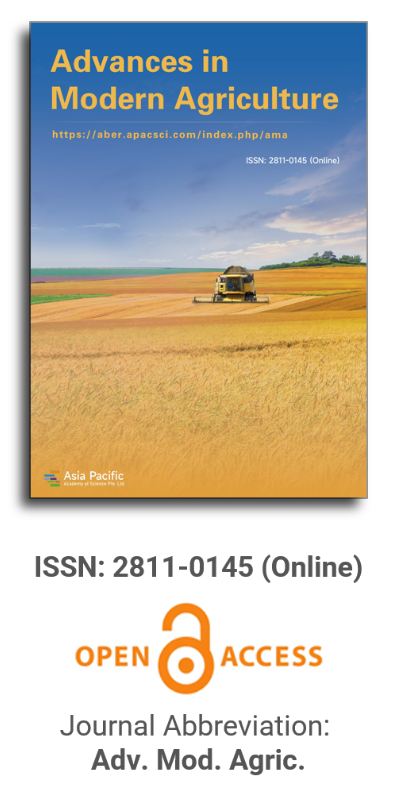


Predictive modeling of evapotranspiration using Long Short-Term Memory and explainable Artificial Intelligence
Vol 6, Issue 3, 2025
VIEWS - 691 (Abstract)
Download PDF
Abstract
Evapotranspiration (ET) modeling plays a vital role in water resource management, agriculture, and climate adaptation. Accurate ET prediction is essential for effective irrigation planning and crop management. However, traditional methods often struggle to capture the complex relationships between environmental factors, resulting in less reliable forecasts. To address this, we implemented and optimized the Long Short-Term Memory (LSTM) network model to predict ET with improved accuracy of 98.8%, achieving a Mean Squared Error (MSE) of 0.12. Our approach incorporates SHapley Additive exPlanations (SHAP) to enhance model interpretability, offering insights into how key factors like solar radiation, wind speed, air temperature, and relative humidity impact ET predictions. The results showed that solar radiation had the highest impact on ET, followed by wind speed and air temperature. This improved understanding of key factors can help farmers and water managers make better decisions about irrigation, ensuring efficient water use and supporting sustainable agriculture. This provides a reliable and interpretable solution for ET prediction, aiding smarter irrigation strategies, improving resource efficiency, and supporting sustainable agricultural practices.
Keywords
References
1. Granata F. Evapotranspiration evaluation models based on machine learning algorithms—A comparative study. Agricultural Water Management. 2019; 217: 303–315. doi: 10.1016/j.agwat.2019.03.015
2. Fereres E, García-Vila M. Irrigation Management for Efficient Crop Production. In: Meyers RA (editor). Encyclopedia of Sustainability Science and Technology. Springer; 2019. pp. 345–360.
3. Ben Abdallah E, Grati R, Boukadi K. Towards an explainable irrigation scheduling approach by predicting soil moisture and evapotranspiration via multi-target regression. Journal of Ambient Intelligence and Smart Environments. 2023; 15: 89–110. doi: 10.3233/AIS-220086
4. Goldstein A, Fink L, Meitin A, et al. Applying machine learning on sensor data for irrigation recommendations: revealing the agronomist’s tacit knowledge. Precision Agriculture. 2018; 19(3): 421–444. doi: 10.1007/s11119-017-9531-8
5. Goap A, Sharma D, Shukla AK, et al. An IoT-based smart irrigation management system using machine learning and open-source technologies. Computers and Electronics in Agriculture. 2018; 155: 41–49. doi: 10.1016/j.compag.2018.09.040
6. Arrieta AB, Díaz-Rodríguez N, Del Ser J, et al. Explainable Artificial Intelligence (XAI): Concepts, taxonomies, opportunities and challenges toward responsible AI. Information Fusion. 2020; 58: 82–115. doi: 10.1016/j.inffus.2019.12.012
7. Chakraborty D, Başagaoglu H, Winterle J. Interpretable vs. non-interpretable machine learning models for data-driven hydro-climatological process modeling. Expert Systems with Applications. 2021; 170: 114498. doi: 10.1016/j.eswa.2020.114498
8. Dikshit A, Pradhan B. Explainable AI in drought forecasting. Machine Learning with Applications. 2021; 6: 100192. doi: 10.1016/j.mlwa.2021.100192
9. Di Bucchianico A. Coefficient of Determination (R2). In: Encyclopedia of Statistics in Quality and Reliability. John Wiley & Sons, Ltd; 2008. doi: 10.1002/9780470061572.eqr173
10. Hochreiter S, Schmidhuber J. Long short-term memory. Neural Computation. 1997; 9(8): 1735–1780. doi: 10.1162/neco.1997.9.8.1735
11. Wu T, Zhang W, Jiao X, Guo W, Hamoud YA, et al. Evaluation of stacking and blending ensemble learning methods for estimating daily reference evapotranspiration. Computers and Electronics in Agriculture. 2021; 184: 106039. doi: 10.1016/j.compag.2021.106039
12. Koné BA, Grati R, Bouaziz B, Boukadi K. Explainable Machine Learning for Evapotranspiration Prediction. In: Proceedings of the 20th International Conference on Informatics in Control, Automation and Robotics (ICINCO 2023); 13-15 November 2023; Rome, Italy. pp. 97–104. doi: 10.5220/0012253200003543
13. Zhao X, Zhang L, Zhu G, et al. Exploring interpretable and non-interpretable machine learning models for estimating winter wheat evapotranspiration using particle swarm optimization with limited climatic data. Computers and Electronics in Agriculture. 2023; 212: 108140. doi: 10.1016/j.compag.2023.108140
14. Acharki S, Raza A, Vishwakarma DK, et al. Comparative assessment of empirical and hybrid machine learning models for estimating daily reference evapotranspiration in sub-humid and semi-arid climates. Scientific Reports. 2025; 15(1): 2542. doi: 10.1038/s41598-024-83859-6
15. Shi B, Yuan Y, Zhuang T, et al. Improving water status prediction of winter wheat using multi-source data with machine learning. European Journal of Agronomy. 2022; 139: 126548. doi: 10.1016/j.eja.2022.126548
16. Hadadi F, Moazenzadeh R, Mohammadi B. Estimation of actual evapotranspiration: A novel hybrid method based on remote sensing and artificial intelligence. Journal of Hydrology. 2022; 609: 127774. doi: 10.1016/j.jhydrol.2022.127774
17. Bellido-Jiménez JA, Estévez J, Vanschoren J, et al. AgroML: An open-source repository to forecast reference evapotranspiration in different geo-climatic conditions using machine learning and transformer-based models. Agronomy. 2022; 12(3): 656. doi: 10.3390/agronomy12030656
18. Zhang H, Wang G, Li S, et al. Understanding Evapotranspiration Driving Mechanisms in China with Explainable Machine Learning Algorithms. International Journal of Climatology. 2025; 45(6). doi: 10.1002/joc.8774
19. Vaz PJ, Schütz G, Guerrero C, Cardoso PJS. Hybrid Neural Network Based Models for Evapotranspiration Prediction Over Limited Weather Parameters. IEEE Access. 2023; 11: 963–976. doi: 10.1109/ACCESS.2022.3233301
20. Khairan HE, Zubaidi SL, Muhsen YR, et al. Parameter optimisation-based hybrid reference evapotranspiration prediction models: A systematic review of current implementations and future research directions. Atmosphere. 2022; 14(1): 77. doi: 10.3390/atmos14010077
21. Hu X, Shi L, Lin G, et al. Comparison of physical-based, data-driven and hybrid modeling approaches for evapotranspiration estimation. Journal of Hydrology. 2021; 601: 126592. doi: 10.1016/j.jhydrol.2021.126592
22. Ghosal S, Blystone D, Singh AK, et al. An explainable deep machine vision framework for plant stress phenotyping. Proceedings of the National Academy of Sciences of the United States of America. 2018; 115(18): 4613–4618. doi: 10.1073/pnas.1716999115
23. Goyal P, Kumar S, Sharda R. A review of the Artificial Intelligence (AI) based techniques for estimating reference evapotranspiration: Current trends and future perspectives. Computers and Electronics in Agriculture. 2023; 209: 107836. doi: 10.1016/j.compag.2023.107836
24. Talib A, Desai AR, Huang J, et al. Evaluation of prediction and forecasting models for evapotranspiration of agricultural lands in the Midwest US. Journal of Hydrology. 2021; 600: 126579. doi: 10.1016/j.jhydrol.2021.126579
25. Hameed MM, AlOmar MK, Razali SFM, et al. Application of artificial intelligence models for evapotranspiration prediction along the southern coast of Turkey. Complexity. 2021; 2021: 8850243. doi: 10.1155/2021/8850243
26. Su H, McCabe MF, Wood EF, et al. Modeling evapotranspiration during SMACEX: Comparing two approaches for local-and regional-scale prediction. Journal of Hydrometeorology. 2005; 6(6): 910–922. doi: 10.1175/JHM464.1
27. Sun G, Alstad K, Chen J, et al. A general predictive model for estimating monthly ecosystem evapotranspiration. Ecohydrology. 2011; 4(2): 245–255. doi: 10.1002/eco.194
28. Mostafa RR, Kisi O, Adnan RM, et al. Modeling potential evapotranspiration by improved machine learning methods using limited climatic data. Water. 2023; 15(3): 486. doi: 10.3390/w15030486
29. Zhao L, Xia J, Xu C, et al. Evapotranspiration estimation methods in hydrological models. Journal of Geographical Sciences. 2013; 23: 359–369. doi: 10.1007/s11442
Supporting Agencies
Copyright (c) 2025 Author(s)
License URL: https://creativecommons.org/licenses/by/4.0/

This site is licensed under a Creative Commons Attribution 4.0 International License (CC BY 4.0).

Prof. Zhengjun Qiu
Zhejiang University, China

Cheng Sun
Academician of World Academy of Productivity Science; Executive Chairman, World Confederation of Productivity Science China Chapter, China
Indexing & Archiving
In the realm of modern agriculture, the integration of cutting-edge technologies is revolutionizing the way we approach sustainable farming practices. A recent study published in Advances in Modern Agriculture titled "Classification of cotton water stress using convolutional neural networks and UAV-based RGB imagery" has garnered significant attention for its innovative approach to precision irrigation management. Conducted by researchers from Institute of Data Science and the AgriLife Research and Extension Center of Texas A&M University (authors's information is below). This study introduces a novel method for classifying cotton water stress using unmanned aerial vehicles (UAVs) and convolutional neural networks (CNNs), offering a powerful solution for optimizing water use in agriculture.
Modern agricultural technology is evolving rapidly, with scientists collaborating with leading agricultural enterprises to develop intelligent management practices. These practices utilize advanced systems that provide tailored fertilization and treatment options for large-scale land management.
This journal values human initiative and intelligence, and the employment of AI technologies to write papers that replace the human mind is expressly prohibited. When there is a suspicious submission that uses AI tools to quickly piece together and generate research results, the editorial board of the journal will reject the article, and all journals under the publisher's umbrella will prohibit all authors from submitting their articles.
Readers and authors are asked to exercise caution and strictly adhere to the journal's policy regarding the usage of Artificial Intelligence Generated Content (AIGC) tools.
Asia Pacific Academy of Science Pte. Ltd. (APACSCI) specializes in international journal publishing. APACSCI adopts the open access publishing model and provides an important communication bridge for academic groups whose interest fields include engineering, technology, medicine, computer, mathematics, agriculture and forestry, and environment.



.jpg)
.jpg)

.jpg)
